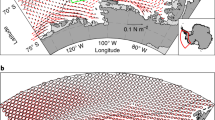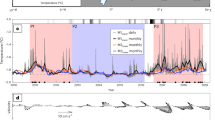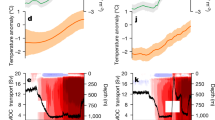Abstract
The Antarctic ice sheet loses mass at its fringes bordering the Southern Ocean. At this boundary, warm circumpolar water can override the continental slope front, reaching the grounding line1,2 through submarine glacial troughs and causing high rates of melting at the deep ice-shelf bases3,4. The interplay between ocean currents and continental bathymetry is therefore likely to influence future rates of ice-mass loss. Here we show that a redirection of the coastal current into the Filchner Trough and underneath the Filchner–Ronne Ice Shelf during the second half of the twenty-first century would lead to increased movement of warm waters into the deep southern ice-shelf cavity. Water temperatures in the cavity would increase by more than 2 degrees Celsius and boost average basal melting from 0.2 metres, or 82 billion tonnes, per year to almost 4 metres, or 1,600 billion tonnes, per year. Our results, which are based on the output of a coupled ice–ocean model forced by a range of atmospheric outputs from the HadCM35 climate model, suggest that the changes would be caused primarily by an increase in ocean surface stress in the southeastern Weddell Sea due to thinning of the formerly consolidated sea-ice cover. The projected ice loss at the base of the Filchner–Ronne Ice Shelf represents 80 per cent of the present Antarctic surface mass balance6. Thus, the quantification of basal mass loss under changing climate conditions is important for projections regarding the dynamics of Antarctic ice streams and ice shelves, and global sea level rise.
This is a preview of subscription content, access via your institution
Access options
Subscribe to this journal
Receive 51 print issues and online access
$199.00 per year
only $3.90 per issue
Buy this article
- Purchase on Springer Link
- Instant access to full article PDF
Prices may be subject to local taxes which are calculated during checkout



Similar content being viewed by others
References
Walker, D. P. et al. Oceanic heat transport onto the Amundsen Sea shelf through a submarine glacial trough. Geophys. Res. Lett. 34, L02602 (2007)
Hellmer, H. H., Jacobs, S. S. & Jenkins, A. in Ocean, Ice, and Atmosphere: Interactions at the Antarctic Continental Margin (eds Jacobs, S. S. & Weiss, R. F. ) 83–99 (Antarctic Res. Ser. 75, American Geophysical Union, 1998)
Jacobs, S. S., Jenkins, A., Giulivi, C. & Dutrieux, P. Stronger ocean circulation and increased melting under Pine Island Glacier ice shelf. Nature Geosci. 4, 519–523 (2011)
Payne, A. J. et al. Numerical modeling of ocean-ice interactions under Pine Island Bay’s ice shelf. J. Geophys. Res. 112, C10019 (2007)
Gordon, C. et al. The simulation of SST, sea ice extents and ocean heat transports in a version of the Hadley Centre coupled model without flux adjustments. Clim. Dyn. 16, 147–168 (2000)
Rignot, E. et al. Acceleration of the contribution of the Greenland and Antarctic ice sheets to sea level. Geophys. Res. Lett. 38, L05503 (2011)
Schröder, M. & Fahrbach, E. On the structure and the transport in the eastern Weddell Gyre. Deep-Sea Res. II 46, 501–527 (1999)
Schröder, M., Hellmer, H. H. & Absy, J. M. On the near-bottom variability at the tip of the Antarctic Peninsula. Deep-Sea Res. II 49, 4767–4790 (2002)
Nicholls, K. W., Boehme, L., Biuw, M. & Fedak, M. A. Wintertime ocean conditions over the southern Weddell Sea continental shelf, Antarctica. Geophys. Res. Lett. 35, L21605 (2008)
Foldvik, A., Gammelsrød, T. & Tørresen, T. in Oceanology of the Antarctic Continental Shelf (ed. Jacobs, S. S. ) 5–20 (Antarctic Res. Ser. 43, American Geophysical Union, 1985)
Makinson, K. & Nicholls, K. W. Modeling tidal currents beneath Filchner-Ronne Ice Shelf and the adjacent continental shelf: their effect on mixing and transport. J. Geophys. Res. 104, 13449–13465 (1999)
Nicholls, K. W. Predicted reduction in basal melt rates of an Antarctic ice shelf in a warmer climate. Nature 388, 460–462 (1997)
Bamber, J. L., Riva, R. E. M., Vermeersen, B. L. A. & LeBrocq, A. Reassessment of the potential sea-level rise from a collapse of the West Antarctic Ice Sheet. Science 324, 901–903 (2009)
Jenkins, A. et al. Observations beneath Pine Island Glacier in West Antarctica and implications for its retreat. Nature Geosci. 3, 468–472 (2010)
Bamber, J. L., Vaughan, D. G. & Joughin, I. Widespread complex flow in the interior of the Antarctic ice sheet. Science 287, 1248–1250 (2000)
Beckmann, A., Hellmer, H. H. & Timmermann, R. A numerical model of the Weddell Sea: large-scale circulation and water mass distribution. J. Geophys. Res. 104, 23375–23391 (1999)
Collins, M. et al. Climate model errors, feedbacks and forcings: a comparison of perturbed physics and multi-model ensembles. Clim. Dyn. 36, 1737–1766 (2011)
Johns, T. C. et al. Climate change under aggressive mitigation: The ENSEMBLES multi-model experiment. Clim. Dyn. 37, 1975–2004 (2011)
Lowe, J. A. et al. New study for climate modelling, analyses, and scenarios. Eos 90, 181–182 (2009)
Nakicevovic, N. et al. IPCC Special Report on Emissions Scenarios (Cambridge Univ. Press, 2000)
Parkinson, C. L. & Washington, W. M. A large-scale numerical model of sea ice. J. Geophys. Res. 84, 311–337 (1979)
Hibler, W. D., III A dynamic thermodynamic sea ice model. J. Phys. Oceanogr. 9, 815–846 (1979)
Hellmer, H. H. Impact of Antarctic ice shelf basal melting on sea ice and deep ocean properties. Geophys. Res. Lett. 31, L10307 (2004)
Timmermann, R., Beckmann, A. & Hellmer, H. H. Simulations of ice-ocean dynamics in the Weddell Sea: 1. Model configuration and validation. J. Geophys. Res. 107, 3024 (2002)
Assmann, K. M., Hellmer, H. H. & Jacobs, S. S. Amundsen Sea ice production and transport. J. Geophys. Res. 110, C12013 (2005)
Lichey, C. & Hellmer, H. H. Modeling giant-iceberg drift under the influence of sea ice in the Weddell Sea, Antarctica. J. Glaciol. 47, 452–460 (2001)
Kalnay, E. M. et al. The NCEP/NCAR 40-year reanalysis project. Bull. Am. Meteorol. Soc. 77, 437–471 (1996)
Timmermann, R. et al. Ocean circulation and sea ice distribution in a finite element global sea ice–ocean model. Ocean Model. 27, 114–129 (2009)
Timmermann, R. et al. A consistent dataset of Antarctic ice sheet topography, cavity geometry, and global bathymetry. Earth Syst. Sci. Data 2, 261–273 (2010)
Walker, R. T. & Holland, D. M. A two-dimensional coupled model for ice shelf-ocean interaction. Ocean Model. 17, 123–139 (2007)
Gordon, A. L., Visbeck, M. & Huber, B. Export of Weddell Sea deep and bottom water. J. Geophys. Res. 106, 9005–9017 (2001)
Acknowledgements
We thank C. Wübber and W. Cohrs for providing stable computer facilities at the Alfred-Wegener-Institute for Polar and Marine Research; the Ice2Sea community for discussions during project meetings; and J. Ridley, M. Martin and A. Levermann for comments on the manuscript. This work was supported by funding to the Ice2Sea programme from the European Union Seventh Framework Programme, grant number 226375. This is Ice2Sea contribution number 41.
Author information
Authors and Affiliations
Contributions
H.H.H. had the idea to force BRIOS with Intergovernmental Panel on Climate Change scenarios, did 50% of the BRIOS simulations, conducted a significant part of the analysis of model output, wrote the main text of the paper and participated in the figure preparation. F.K. did 50% of the BRIOS simulations, conducted the analysis of the atmospheric forcing and wrote Supplementary Information. R.T. did all FESOM simulations, was involved in the analysis of model output and prepared most of the figures. J.D. provided the glaciological expertise for the interpretation of the model results related to basal mass loss. J.R. extracted the atmospheric forcings for all simulations and was involved in the analysis of model output. All authors participated in the discussion on model results and in drafting the paper.
Corresponding author
Ethics declarations
Competing interests
The authors declare no competing financial interests.
Supplementary information
Supplementary Information
This file contains Supplementary Text and Supplementary Figures 1-5. (PDF 7136 kb)
Rights and permissions
About this article
Cite this article
Hellmer, H., Kauker, F., Timmermann, R. et al. Twenty-first-century warming of a large Antarctic ice-shelf cavity by a redirected coastal current. Nature 485, 225–228 (2012). https://doi.org/10.1038/nature11064
Received:
Accepted:
Published:
Issue Date:
DOI: https://doi.org/10.1038/nature11064
This article is cited by
-
Slowdown of Antarctic Bottom Water export driven by climatic wind and sea-ice changes
Nature Climate Change (2023)
-
Future sea-level projections with a coupled atmosphere-ocean-ice-sheet model
Nature Communications (2023)
-
Response of the East Antarctic Ice Sheet to past and future climate change
Nature (2022)
-
Petermann ice shelf may not recover after a future breakup
Nature Communications (2022)
-
Abruptly attenuated carbon sequestration with Weddell Sea dense waters by 2100
Nature Communications (2022)
Comments
By submitting a comment you agree to abide by our Terms and Community Guidelines. If you find something abusive or that does not comply with our terms or guidelines please flag it as inappropriate.



